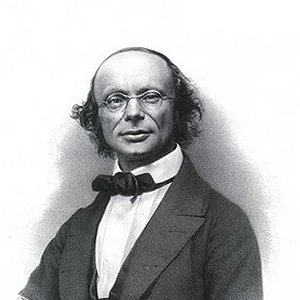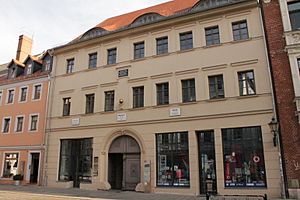Wilhelm Eduard Weber facts for kids
Quick facts for kids
Wilhelm Weber
|
|
|---|---|
 |
|
| Born |
Wilhelm Eduard Weber
24 October 1804 Wittenberg, Saxony, Holy Roman Empire
|
| Died | 23 June 1891 (aged 86) |
| Nationality | German |
| Alma mater | University of Halle University of Göttingen |
| Known for | First use of c for speed of light Work on magnetism Electrodynamometer Telegraphy |
| Awards | Copley Medal (1859) Matteucci Medal (1879) |
| Scientific career | |
| Fields | Physics |
| Institutions | University of Göttingen University of Halle University of Leipzig |
| Doctoral advisor | Johann Salomo Christoph Schweigger |
| Doctoral students | Ernst Abbe Friedrich Kohlrausch Eduard Riecke |
| Other notable students | Gottlob Frege Arthur Schuster |
| Signature | |
| Notes | |
|
The SI unit of magnetic flux is named after him. He was the brother of Ernst Heinrich Weber and Eduard Friedrich Weber. His father was Michael Weber.
|
|
Wilhelm Eduard Weber (born October 24, 1804 – died June 23, 1891) was a German physicist. He is famous for inventing the first electromagnetic telegraph with Carl Friedrich Gauss.
Contents
About Wilhelm Weber
His Early Life and Education
Wilhelm Weber was born in Wittenberg, Germany. His father, Michael Weber, was a professor of theology. Wilhelm was the second of three brothers. All of them were very good at science.
When he was young, Wilhelm learned from his father. Later, he went to a school and then to the University of Halle. He was an excellent student. He did so well that he became a professor of natural philosophy at Halle. He was only 20 years old when he wrote a book about waves and fluids with his brother, Ernst Heinrich Weber. This book made them quite famous.
His Amazing Career and Discoveries
In 1831, when he was 27, Wilhelm Weber became a physics professor at the University of Göttingen. This happened because Carl Friedrich Gauss, a very famous scientist, recommended him.
Weber made his classes exciting. He believed that students should not just listen to lectures. He wanted them to do experiments themselves. So, he let his students use the college laboratory for free.
He loved the science of sound, called acoustics. He wrote many papers about it. He also studied how humans walk with his younger brother, Eduard Weber.
One of his biggest achievements was with Carl Friedrich Gauss. In 1833, they built the first electromagnetic telegraph. This device connected the observatory with the physics institute in Göttingen. It was a huge step for communication!
In 1837, Weber lost his job at the university for political reasons. He was one of the "Göttingen Seven," a group of professors who protested against the government. After traveling for a while, he became a physics professor in Leipzig. He returned to Göttingen in 1849.
Weber continued his work on magnetism with Gauss. They created an Atlas of Geomagnetism. This was a series of maps showing Earth's magnetic field. Thanks to his efforts, many magnetic observatories were built.
In 1864, he published his work on "Electrodynamic Proportional Measures." This book introduced a system for measuring electric currents. This system is still used today as a basis for modern measurements.
His Work on the Speed of Light
In 1856, Weber worked with Rudolf Kohlrausch. They showed that the ratio of electrostatic units to electromagnetic units was a number that matched the known speed of light. This was a very important discovery! It helped James Clerk Maxwell suggest that light is an electromagnetic wave. Also, Weber and Kohlrausch were the first to use the letter "c" to represent the speed of light.
Wilhelm Weber passed away in Göttingen in 1891. He is buried in the same cemetery as other famous scientists like Max Planck.
International Recognition
The SI unit for magnetic flux is named after him. It is called the weber (symbol: Wb). This shows how important his work was in the field of magnetism.
See also
 In Spanish: Wilhelm Eduard Weber para niños
In Spanish: Wilhelm Eduard Weber para niños
- German inventors and discoverers
- International System of Electrical and Magnetic Units
- Bifilar coil
- Needle telegraph
- Vector magnetic potential
- Weber electrodynamics
Images for kids




